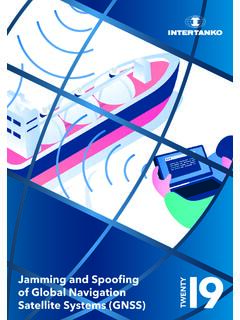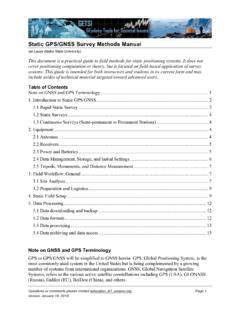Transcription of Introduction to Global Positioning Systems (GPS)
1 1 Prepared for USDAI ntroduction toGlobal Positioning Systems (GPS)Maryland NRCSA ugust 20072 Topics GPS function & terminology GPS applications in NRCS Garmin GPS 76 for Data Collection3 NAVSTAR Navigational Satellite Timing And RangingI. What is GPS? Precisely identify locations on earth by measuring distances from the satellitesGPS is a Positioning system based on a network of satellites that continuously transmit coded information. The information transmitted from the satellites can be interpreted by receivers to precisely identify locations on earth by measuring distances from the is funded by and controlled by the Department of Defense (DOD).
2 The system is called Components to GPSS pace Segment-the satellites orbiting the earth and transmitting timing and ranging messagesUser Segment- the hand-held or other receivers used to interpret the messages broadcast from the satellitesControl Segment-monitors the health and position of the satellites in the space segment and transmits correction information back up to the satellites5 The nominal GPS Operational Constellation consists of roughly 24satellites. Each satellite has a number on your GPS screen. Newer satellites have been sent up to replace older ones.
3 The GPS signal communicates information about the precise position of the satellite and the precise time of the signal. Each satellite orbits the earth in about 12 hours. The satellite orbits repeat roughly the same ground track each day. Learn to identify the time of day when satellite coverage is best in your area and plan your field work ConstellationSource: Peter H. Dana, The University of Colorado. and 3-D PositioningSince we exist in three dimensions, theoretically we need to get our distance from three satellites. The scenario above is theoretical because it supposes that we know exactly how far we are from the satellites.
4 In order to get our GPS clock in synch with the satellite clocks, we need to get data from a fourth satellite to calculate the time offset and set our GPS clock to near perfect system line: You need at least 3 satellites to get a 2-Dimensional position and 4 satellites to get a 3-D of decrease the accuracy of your GPS readings Number and geometry of satellites visible Signal multi-path Orbital and Satellite Clock errors Ionosphere and troposphere delays Receiver clock errorsGPS position is not perfect . Some errors you have some control over.
5 As a GPS user, you have some control over the first type of error - you can wait for the satellites to move into better geometry or plan your data collection for a good time of day. You cannot control multi-path error, but you do need to recognize when it may occur and pay close attention to the measurements that you are taking. Orbital and Satellite Clock errors as well as atmospheric delays are invisible to you, but you can avoid them by using differential correction. There is nothing that you can do about your receiver clock errors.
6 GPS receivers will generally report an estimate of the accuracy of the position being reported by the unit at the Differential Global Positioning Systems DGPS improves the accuracy and integrity of standard GPS DGPS works by placing a GPS receiver at a known location, this is called a reference station The reference station knows its exact location, and therefore can calculate the difference between the GPS derived positions and the true position. The reference station calculates the errors in the GPS signals by comparing its known position to the position derived from the satellite signals.
7 The stations actually calculate the differences between measured and actual ranges for each of the satellites visible from that station. This calculated difference is called the differential correction for that satellite. In real time DGPS, the correction signals are broadcast from the reference station and used immediately by the roving GPS to correct the position data being collected. There are two main sources of real time DGPS that USDA Nationwide Differential Global Positioning SystemThe Coast Guard operates a network of reference stations known as the Coast Guard Maritime Differential GPS Service as well as the developing Nationwide DGPS type of frequency that the NDGPS uses is ground following , meaning that it will not be blocked by most terrain features in its operating range.
8 This means that the GPS user does not need to have a clear line of site to the DGPS transmitter. GPS users can use this signal if they have specialized receivers like the MBX-3 that is included in the USDA GPS configuration Nationwide Differential Global Positioning SystemKnown PositionCoast Guardbase station and differential transmitterDifferential correction signalsent in real timeMobile GPS unitGPS SignalGPS Signal11 Wide Area Augmentation system (WAAS)WAAS is a DGPS system implemented by the Federal Aviation Administration and designed primarily for aviation users.
9 The system uses 25 ground reference stations to generate a nation-wide correction message. This message is then uploaded to two geo-synchronous satellites. The WAAS satellites then beam the correction message back to GPS users on the L1 frequency, the same frequency that the GPS signal is broadcast target accuracy of this system is 7 meters horizontal and vertical, testing has found it to be in the 3-5 meter has some serious limitations for users on the ground because the L1 frequency is line of sight , meaning that it can be blocked by terrain, buildings, etc.
10 12 Wide Area Augmentation system (WAAS)Mobile GPS unitGPS SatellitesWAAS SatelliteDifferential Correction Signal13 GPS Error NOT Addressed by DGPS Poor Satellite Geometry Poor Satellite Visibility Multipath Interference14 GPS Error NOT Addressed by DGPS DGPS can eliminate some errors that were discussed in the last slide but not all of them. Satellites that are bunched in the sky will give a less accurate position than if those satellites were more evenly distributed in the sky. If the satellites are hidden by trees, buildings etc then they can not be used to determine position.














